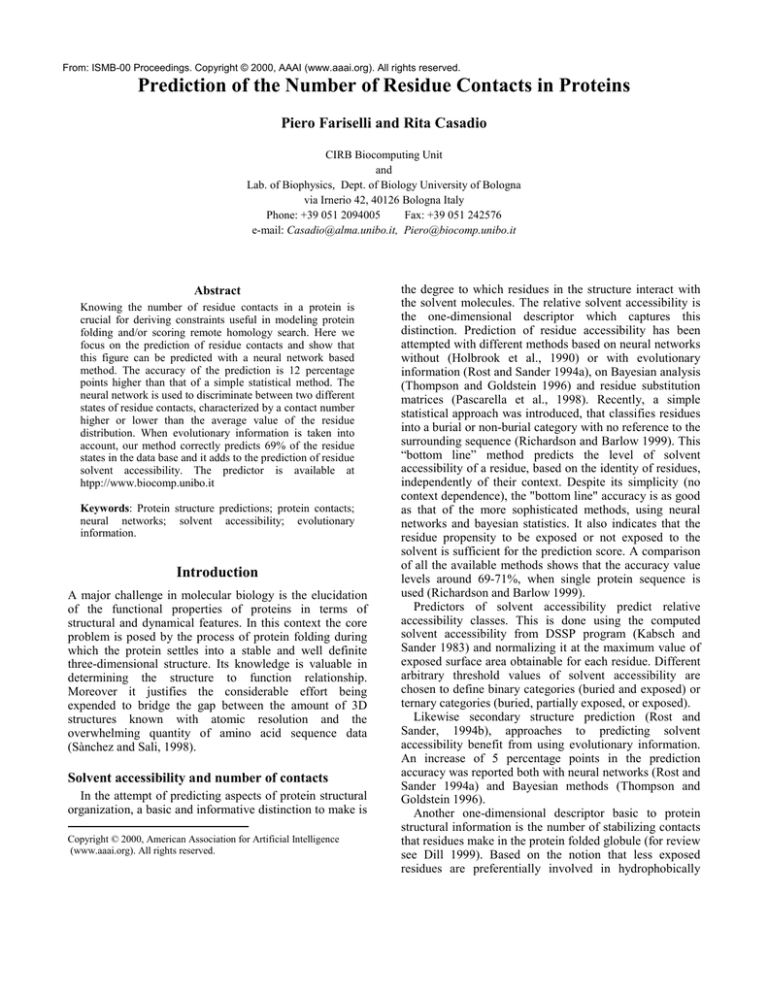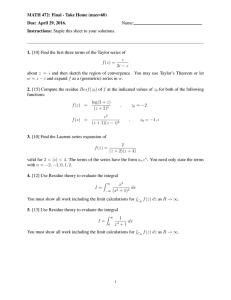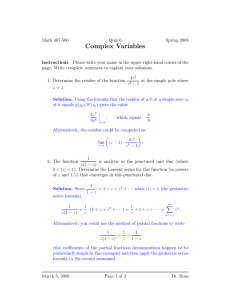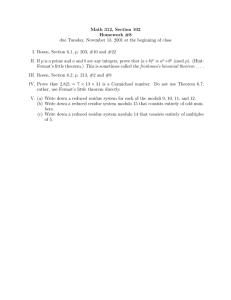
From: ISMB-00 Proceedings. Copyright © 2000, AAAI (www.aaai.org). All rights reserved.
Prediction of the Number of Residue Contacts in Proteins
Piero Fariselli and Rita Casadio
CIRB Biocomputing Unit
and
Lab. of Biophysics, Dept. of Biology University of Bologna
via Irnerio 42, 40126 Bologna Italy
Phone: +39 051 2094005
Fax: +39 051 242576
e-mail: Casadio@alma.unibo.it, Piero@biocomp.unibo.it
Abstract
Knowing the number of residue contacts in a protein is
crucial for deriving constraints useful in modeling protein
folding and/or scoring remote homology search. Here we
focus on the prediction of residue contacts and show that
this figure can be predicted with a neural network based
method. The accuracy of the prediction is 12 percentage
points higher than that of a simple statistical method. The
neural network is used to discriminate between two different
states of residue contacts, characterized by a contact number
higher or lower than the average value of the residue
distribution. When evolutionary information is taken into
account, our method correctly predicts 69% of the residue
states in the data base and it adds to the prediction of residue
solvent accessibility. The predictor is available at
htpp://www.biocomp.unibo.it
Keywords: Protein structure predictions; protein contacts;
neural networks; solvent accessibility; evolutionary
information.
Introduction
A major challenge in molecular biology is the elucidation
of the functional properties of proteins in terms of
structural and dynamical features. In this context the core
problem is posed by the process of protein folding during
which the protein settles into a stable and well definite
three-dimensional structure. Its knowledge is valuable in
determining the structure to function relationship.
Moreover it justifies the considerable effort being
expended to bridge the gap between the amount of 3D
structures known with atomic resolution and the
overwhelming quantity of amino acid sequence data
(Sànchez and Sali, 1998).
Solvent accessibility and number of contacts
In the attempt of predicting aspects of protein structural
organization, a basic and informative distinction to make is
Copyright © 2000, American Association for Artificial Intelligence
(www.aaai.org). All rights reserved.
the degree to which residues in the structure interact with
the solvent molecules. The relative solvent accessibility is
the one-dimensional descriptor which captures this
distinction. Prediction of residue accessibility has been
attempted with different methods based on neural networks
without (Holbrook et al., 1990) or with evolutionary
information (Rost and Sander 1994a), on Bayesian analysis
(Thompson and Goldstein 1996) and residue substitution
matrices (Pascarella et al., 1998). Recently, a simple
statistical approach was introduced, that classifies residues
into a burial or non-burial category with no reference to the
surrounding sequence (Richardson and Barlow 1999). This
“bottom line” method predicts the level of solvent
accessibility of a residue, based on the identity of residues,
independently of their context. Despite its simplicity (no
context dependence), the "bottom line" accuracy is as good
as that of the more sophisticated methods, using neural
networks and bayesian statistics. It also indicates that the
residue propensity to be exposed or not exposed to the
solvent is sufficient for the prediction score. A comparison
of all the available methods shows that the accuracy value
levels around 69-71%, when single protein sequence is
used (Richardson and Barlow 1999).
Predictors of solvent accessibility predict relative
accessibility classes. This is done using the computed
solvent accessibility from DSSP program (Kabsch and
Sander 1983) and normalizing it at the maximum value of
exposed surface area obtainable for each residue. Different
arbitrary threshold values of solvent accessibility are
chosen to define binary categories (buried and exposed) or
ternary categories (buried, partially exposed, or exposed).
Likewise secondary structure prediction (Rost and
Sander, 1994b), approaches to predicting solvent
accessibility benefit from using evolutionary information.
An increase of 5 percentage points in the prediction
accuracy was reported both with neural networks (Rost and
Sander 1994a) and Bayesian methods (Thompson and
Goldstein 1996).
Another one-dimensional descriptor basic to protein
structural information is the number of stabilizing contacts
that residues make in the protein folded globule (for review
see Dill 1999). Based on the notion that less exposed
residues are preferentially involved in hydrophobically
driven chain compaction, solvent accessibility has been
routinely used to evaluate also the number of residue
contacts. In order to simulate the hydrophobic collapse in
model proteins the number of residue contacts is chosen as
the inverse measure of the residue solvent accessibility and
in the case of simple lattice protein models, it is the only
source of interaction (Sali et al., 1994).
In this paper we show that although a strict connection
between accessibility and contact number is commonly
accepted, residue surface accessibility is differently
distributed than the number of residue contacts in a data
base of selected proteins and that residue classification
may be different depending on which property is
highlighted. Therefore a direct prediction of the number of
residue contacts is worth in many cases.
Relevance of residue contact information
Knowing the correct positions of residue contacts in
proteins has been proven extremely useful to determine the
three-dimensional structure of a given protein, as it was
recently demonstrated in the CASP3 competition (CASP3,
Ortiz et al., 1999). Moreover, when remote homology is
searched, it is very profitable to derive a surface potential
based on the distribution of contact numbers for each
residue. This is computed by implementing the inverse of
the Boltzman rule (Flökner et al., 1995) or by using the
notion of contacts among residues to improve existing
threading algorithms (Olmea et al., 1999).
In an off-lattice context the number of contacts for each
residue is computed inside a spherical cut-off centered into
each residue and by counting the number of residues
falling inside a defined volume (Flöckner et al., 1995).
In the last few years different attempts to predict
contacts (Shindyalov et al., 1994; Olmea and Valencia,
1997; Fariselli and Casadio 1999) and distances among
residues in proteins (Aszodi et al., 1995; Lund et al. 1997;
Gorodkin et al., 1999) have been made with some extent of
success.
In this paper we develop a predictor capable of
discriminating if a given residue, depending on its
sequence context, has a number of contacts greater or
lower than its average value in the data base. This type of
classification is complementary to predicting residue
solvent accessibility and can be used to improve methods
suited to predict protein structure.
The Method
The protein data base
Neural networks are trained and tested on a database of
proteins selected from the Protein Data Bank using the
PDB_select algorithm (Hobohm et al., 1992). For the
training phase proteins with an identity value <25% were
extracted
from
the
PDB_select_oct_1997
file
(http://www.embl-heidelberg.de). This set was then
reduced by excluding those chains whose backbone is
interrupted. The final set is listed in Appendix 1 using the
PDB acronyms.
When single sequences were used, inputs of the
predictor were derived from the PDB files; in the case of
multiple sequence inputs, the sequence profiles generated
with the MaxHom program were extracted from the HSSP
files (Schneider and Sander, 1991).
Computation of residue solvent accessibility and
contact number
Residue solvent accessibility is evaluated by using the
DSSP program (Kabsch and Sander 1983). The value is
normalized to the maximal exposed surface area of each
residue (Rose et al., 1985) in the data base of selected
proteins (Appendix 1).
The number of inter-residue contacts for each residue of
the data base is computed by defining a spherical protein
volume centered in the Cβ atom (or Cα for GLY) and
with a radius equal to 6.5 Å.
The predictor and the measure of accuracy
Initially, for each residue the frequency distribution of the
number of contacts is computed using the protein data
base. A standard feed-forward neural network based
predictor is then trained (and tested) to classify whether a
given residue, depending on the context of the input
window, has a number of contacts lower or higher than its
average distribution value. The training procedure is
performed using single sequence or sequence profile as
input to the networks.
The training algorithm is back-propagation (Rumelhart
et al. 1986). The network architecture consists of a
perceptron with one hidden layer, and two output neurons.
The number of hidden neurons was changed from 2 to 32
without significantly affecting the predictive performance.
The input window was 1 to 15 residue long, depending on
the test case. The predictor implemented with a 1 residue
long window was used as a “bottom line” reference. This
simple predictor always assigns a residue to its most
abundant class independently of its environment
(Richardson and Barlow, 1999).
A cross validation procedure was adopted by splitting
the proteins listed in Appendix 1 into 10 subsets of almost
equal size.
In order to score the efficiency we used the following
accuracy indices (Fariselli et al. 1993): Q2 is the number of
correctly predicted residues divided by the total number of
residues; PC is the number of correct assignments to a
given class divided by the number of all the residues
predicted in that class; Q is the number of correct
assignments to a given class divided by the total number of
observed in that class; C is the Matthews’ correlation
coefficient.
Residue solvent accessibility and distribution of
contact numbers
A key point of our work is to elucidate the difference
between solvent accessibility and number of contacts of a
given residue. To this purpose, we first computed the
distributions of solvent accessibility and of contact
numbers for each residue in the protein data base (Figure 1
and 2, respectively). The solvent accessibility distributions
are characterized by three patterns: the first, typical of the
majority of residues (hydrophobic and polar) is
characterized by higher frequencies of occurrence
corresponding to low values of solvent accessibility (in the
range of 10%); the second, comprising charged residues
(except lysine (K)) and glutamine (Q) shows higher
frequency values picking both around 10% and around 4060% accessibility values, respectively; the third typical of
lysine (K) is characterized by frequencies of occurence
peaking around 40%. These data, which are in agreement
with other authors' statistics (Holbrook at al., 1990;
Richardson and Barlow 1999), suggest that a volumetric
effect is dominant over the single residue chemico-physical
characteristics (in a protein, on average, more residues are
buried than exposed on the surface, Janin 1979).
distribution shape, one can speculate that each residue (or
its Cβ atom) has a preferred coordination (its average value
of contacts) around which it fluctuates due to the protein
environment. For this reason a mean force potential based
on the residue contacts can help in the remote homology
search (Flökner et al., 1995).
For each protein of the data base a correlation is
computed between the number of residue contacts and the
residue solvent accessibility of the chain. The correlation
coefficient values obtained, considering both different
contact volumes and different cut-off values of solvent
accessibility, indicate that correlation between the two
descriptors is poor (Table 1). We can conclude that
predicting the number of contacts of a given residue is
different from predicting its solvent accessibility.
0,25
0,2
Freqeuncy
Results and Discussion
0,15
0,1
0,05
A
C
D
E
F
G
H
I
K
L
M
N
P
Q
R
S
T
V
W
Y
0
1
A
C
D
E
F
G
H
I
K
L
M
N
P
Q
R
S
T
V
W
Y
0,7
0,6
Frequency
0,5
0,4
0,3
0,2
0,1
2
3
4
5
6
7
8
9
Number of Contacts
10
11
12
13
Figure 2. Frequency distribution of the number of contacts
for the 20 residues. The residues are plotted using two
different symbols depending on whether the mean value of
their contacts is peaking around 4 (open squares) and
around 7 (filled circles).
Table 1. Correlation coefficients between the numbers of
residue contacts and the relative accessibility of the
proteins in the data base.
0
10
20
30
40
50
60
70
Accessibility (%)
80
90
100
Figure 1. Frequency distribution of the relative solvent
accessibility for the 20 residues. The residues are depicted
using two different symbols depending on the shape of their
distribution: filled circles when the distribution has only one
pick in the low accessibility region and open squares when it
is bimodal or flat.
Alternatively, the distributions of residue contacts are
characterized by a unique pattern (roughly bell-shaped)
independently of the residue type (Figure 2). Distributions
can be apparently distinguished depending on the two
different positions of their maximal frequency value (equal
to the distribution average value). The distributions of
hydrophobic residues, with the only exception of tyrosine
(Y), peak at the highest average value of contacts (6-7)
whereas the distributions of polar and charged residues
peak at the lowest average value (4-5). Given the
Accessibility
Cut-off
Cβ
Cα
9%
16%
50%
0.42
0.35
0.44
0.37
0.39
0.33
Contact numbers are computed using Cβ or Cα atoms as volume
centers and a radius of 6.5 Å. Binary categories (buried or
exposed) were discriminated by choosing three different
percentage threshold values of solvent accessibility.
The predictor at work
The best performing architecture of the predictor was
selected both by changing the number of hidden neurons
(from 2 to 32) and the window input dimension (odd
numbers from 1 to 15). The accuracy of the predictor, at a
fixed number of hidden neurons (4), is shown in Figure 3
as a function of the input window length. A relevant
increase on the accuracy value is noticeable when the
window length is enlarged from 1 to 5 residues. The
accuracy increases by about 5 percentage points in passing
from 1 to 3 residues, and a further 2% is gained with a 5
residue long window. However when larger windows
ranging from 7 to 15 residues are used, the accuracy is
slightly affected. In this range, as already pointed out for
the solvent accessibility prediction, the choice of the
window length has a marginal influence on the results
(Rost and Sander 1994a). The same observation holds
when the number of hidden neurons at optimal window
length is increased: the efficiency is not significantly
affected by increasing the number of hidden neurons above
4.
It is however noticeable (Figure 3) that the use of
multiple sequence alignment in the form of profile
sequence (MS) as input to the network increases the
predictor accuracy of three percentage points as compared
to single sequence (SS). This indicates that the number of
contacts in proteins is to a certain extent a conserved
property. Indeed it is evident that the accuracy is much
lower when the window length of the predictor is one and
the prediction is totally context independent.
The base line predictor and the best performing
predictors, either using single sequence or multiple
75
Table 2. Scoring of the neural network based predictor
Method Q2
Q(L) Q(H) PC(L) PC(H) C
BASE
0.57 1.00
0.00
0.57
0.00
0.00
SS
0.66 0.78
0.48
0.68
0.61
0.28
MS
0.69 0.81
0.51
0.70
0.66
0.35
BASE=baseline method; SS=neural network with single
sequence as input; MS=neural network with multiple sequence
as input; Q2= overall accuracy; Q(L) and Q(H) = accuracy
normalised to the observed residue for the classes L (lower
and equal than the average) and H (higher than the average)
respectively; PC(L) and PC(H) = accuracy normalised to the
predicted residue for the L and H classes, respectively; C =
correlation coefficient. Indexes are computed adopting a cross
validation procedure.
Acknowledgements
Financial support to this work was provided by a grant of
the Ministero della Università e della Ricerca Scientifica e
Tecnologica (MURST) delivered to the project “Structural,
Functional and Applicative Prospects of Proteins from
Termophiles” and by a grant for a target project in
Biotechnology of the Italian Centro Nazionale delle
Ricerche (CNR)
Q2(%)
70
65
SS
Appendix 1. The protein data base
60
MS
55
50
1
3
5
7
9
11
13
15
Window
Figure 3. Testing accuracy of the neural network based
predictor as a function of the length of the input window. The
networks were trained with single sequence (SS) or multiple
sequence (MS) as input and using 4 hidden neurons.
sequence, are compared by evaluating different scoring
indexes (Table 2). The two categories discriminated are
labeled H (higher than the average) and L (lower or equal
to the average). It is evident that both the single sequence
(SS) and multiple sequence (MS) predictors score higher
(up to 12 percentage points with evolutionary information)
than the baseline predictor (BASE).
To our knowledge this is the first attempt to predict the
number of inter-residue contacts in proteins. The use of
neural networks was prompted by the indication that for a
related task (prediction of solvent accessibility) Bayesian
and neural network-based methods perform similarly. We
find that the number of inter-residue contacts in proteins
can be predicted with a good accuracy provided that
context and evolutionary information are taken into
account.
119l_
1aaf_
1ad2_
1ag4_
1ai6a
1ak0_
1amm_
1aoy_
1aq6a
1as4b
1avma
1bak_
1beba
1bgp_
1bncb
1btb_
1c5a_
1cex_
1chma
1cnt2
1ctj_
1dad_
1div_
1dora
1ebpa
1edg_
1esfa
1fcda
1fpka
153l_
1aaya
1ads_
1agna
1aie_
1ak1_
1amp_
1aoza
1aqb_
1ash_
1avob
1bbpa
1benb
1bhmb
1bnda
1btma
1cby_
1cfb_
1cid_
1cnv_
1cto_
1ddf_
1djxa
1dpga
1eca_
1edmb
1etpa
1fdm_
1ftpa
1a0aa
1ab3_
1aerb
1agqd
1aiha
1akjd
1an9a
1ap8_
1aqt_
1asx_
1awcb
1bcmb
1beo_
1bip_
1bor_
1btn_
1cdb_
1cfe_
1clc_
1crka
1cur_
1deaa
1dkgb
1dru_
1ecea
1edt_
1eur_
1fjma
1fua_
1a0b_
1ab8a
1afp_
1agre
1aikc
1ako_
1anu_
1apf_
1ar1a
1asya
1awd_
1bcn_
1bfg_
1bkf_
1bova
1bvh_
1cdi_
1cfh_
1cmke
1csbb
1cyda
1dec_
1dkta
1dubb
1ecmb
1ehs_
1exh_
1flei
1furb
1aa0_
1aba_
1afra
1ah7_
1aj3_
1akz_
1ao7b
1apj_
1arb_
1atib
1awj_
1bct_
1bfma
1ble_
1bp1_
1bvp1
1cds_
1cfya
1cmr_
1csga
1cyx_
1def_
1dkza
1dupa
1ecpa
1erd_
1ezm_
1fmtb
1fvka
1aa2_
1abrb
1afwa
1ah9_
1ajj_
1alo_
1aoca
1apyb
1ark_
1atla
1axib
1bdma
1bfta
1bmfg
1brnl
1bw3_
1cem_
1chd_
1cmyb
1csh_
1d66a
1delb
1dlha
1dxy_
1ecra
1erv_
1fbr_
1fna_
1fwp_
1aa3_
1acp_
1ag2_
1aho_
1ajya
1aly_
1aoqa
1aq0a
1arv_
1atzb
1axn_
1bdo_
1bgk_
1bnb_
1broa
1byb_
1cewi
1chka
1cne_
1csn_
1daaa
1dhr_
1doka
1eal_
1ede_
1esc_
1fc1a
1foka
1gai_
1garb
1glef
1gpmb
1gvp_
1hfc_
1hrya
1hula
1ife_
1irk_
1iyv_
1jli_
1kaz_
1krt_
1lam_
1lfb_
1lpn_
1mai_
1mnmc
1mspb
1ncib
1noya
1nwpa
1ospo
1pdc_
1pft_
1pkp_
1poc_
1prr_
1pyp_
1rcf_
1rmd_
1rusa
1sgpi
1smea
1sro_
1tc3c
1thtb
1tiv_
1tsg_
1uby_
1uxy_
1vhra
1vpsa
2wea_
1xbrb
1yaia
1ytba
1zin_
2acy_
2bopa
2dkb_
2ezh_
2hbg_
2lgsa
2naca
2phy_
2rn2_
2sn3_
2tysa
3cla_
3pte_
4htci
5hpga
7ahla
1gcb_
1gnd_
1gpt_
1gyla
1hgxb
1hsba
1hwha
1igd_
1irl_
1jaca
1jmca
1kid_
1ksr_
1latb
1lgha
1lrv_
1mak_
1mola
1muca
1ngr_
1npk_
1nxb_
1otfa
1pdgc
1pgs_
1plc_
1pot_
1ps1a
1pysa
1regy
1rof_
1rvaa
1shca
1smna
1svb_
1tca_
1thv_
1tle_
1tul_
1udii
1vba4
1vif_
1vsd_
1wer_
1xdtr
1yasa
1ytfc
1znba
2arcb
2cba_
2dri_
2ezk_
2hp8_
2liv_
2ncm_
2pii_
2rslc
2sns_
2ucz_
3cyr_
3r1ra
4mt2_
5icb_
7gata
1gdob
1gnha
1gsa_
1hava
1hjra
1hsn_
1idaa
1igna
1irsa
1jdw_
1jpc_
2kinb
1kte_
1lba_
1lis_
1lt5d
1mbd_
1mpga
1mypa
1nif_
1npoc
1obpa
1otga
1pdnc
1phc_
1plr_
1pou_
1ptq_
1qapa
1res_
1roo_
1ryt_
1skye
1smpi
1svpa
1tdtc
1thx_
1tlk_
1tum_
1ulp_
1vcaa
1vig_
1vtx_
1whi_
1xgsa
1ycc_
1ytw_
1zwd_
2ayh_
2ccya
2drpa
2fha_
2hpda
2masa
2nef_
2plda
2rspb
2spca
2vgh_
3grs_
3sdha
4pgaa
5nul_
7rsa_
1ggga
1gnwa
1gtma
1hcd_
1hlb_
1hsta
1idk_
1ihfa
1isua
1jer_
1jrhi
1kit_
1kuh_
1lbu_
1lki_
1ltsa
1mhlc
1mrj_
1mzm_
1nkl_
1nre_
1ocp_
1oyc_
1pdo_
1php_
1pmi_
1ppn_
1pud_
1qnf_
1rgea
1rpo_
1sbp_
1skz_
1smtb
1svq_
1tfb_
1tib_
1tml_
1tupc
1unka
1vcc_
1vin_
1vvc_
1who_
1xikb
1ycqa
1yub_
1zxq_
2baa_
2cdx_
2dyna
2fiva
2i1b_
2mcm_
2omf_
2pola
2sak_
2stv_
2vhba
3lzt_
3ulla
4pgmb
5p21_
8abp_
1gifa
1goh_
1gtqa
1hcgb
1hloa
1htmb
1ido_
1inp_
1itbb
1jeta
1jsuc
1knb_
1kul_
1lcl_
1lkka
1lucb
1mkaa
1mrp_
1nbab
1nls_
1nsgb
1onra
1p38_
1pea_
1pih_
1pne_
1ppt_
1put_
1quf_
1rgs_
1rro_
1sera
1slta
1smvc
1tabi
1tfe_
1tif_
1tnra
1tvxa
1urna
1vdfa
1vls_
1vwld
1wiu_
1xnb_
1ycsb
1zaq_
256ba
2bbva
2chsa
2ech_
2fow_
2il6_
2mpra
2pac_
2por_
2scpa
2stwa
2vik_
3mdda
4aaha
4rhv1
5pti_
8atcb
1gin_
1gpb_
1gtra
1hcra
1hoe_
1htp_
1if1b
1ipsa
1iva_
1jhga
1jvr_
1knya
1kvu_
1lct_
1lmb4
1lxa_
1mlda
1msc_
1nbba
1noe_
1nsya
1opd_
1pce_
1pex_
1pii_
1pnkb
1prcc
1pyab
1r69_
1rie_
1rsy_
1sfe_
1slua
1sqc_
1tada
1tfpa
1tih_
1tpm_
1uae_
1utg_
1vhh_
1vmoa
1wba_
1wsyb
1xxca
1ysc_
1zdd_
2abd_
2bds_
2ctc_
2end_
2fsp_
2ilk_
2msbb
2pgd_
2ptd_
2sici
2tbd_
3b5c_
3pbga
4dpvz
4xis_
5znf_
8ruci
1gky_
1gpc_
1guqb
1hev_
1hqi_
1htrp
1ifc_
1ipwb
1ixh_
1jkw_
1jxpa
1kpf_
1kzub
1leb_
1lpba
1lxta
1mml_
1msec
1nbca
1nox_
1nula
1opr_
1pcfa
1pfsa
1pioa
1poa_
1prea
1pyda
1ra9_
1rlw_
1rtna
1sfta
1sly_
1sra_
1taha
1thja
1tiid
1trka
1ubi_
1uxd_
1vhp_
1vnc_
1wdca
1wtua
1xyza
1ysth
1zid_
2abk_
2bi6h
2cyp_
2erl_
2gdm_
2ktx_
2mtac
2phla
2pth_
2sil_
2tgi_
3chy_
3pchm
4hmga
5csma
6gsva
8rxna
References
Aszodi, A., Gradwell, M.J., and Taylor, W.R. 1995. Global
fold determination from a small number of distance
restraints J. Mol. Biol. 251:308-326.
CASP3 http://predictioncenter.llnl.gov/casp3/Casp3.html
Dill, K.A. 1999. Polymer principles and protein folding.
Protein Sci. 8:1166-1180.
Fariselli, P., Compiani, M., Casadio, R. 1993. Predicting
secondary structures of membrane proteins with neural
networks Eur Biophys J 22: 41- 51.
Fariselli, P., and Casadio, R. 1999. Neural network based
predictor of residue contacts in proteins. Protein Engng
12:15-21
Flökner, H., Braxenthaler, M., Lackner, P., Jaitz, M.,
Ortner, M., and Sippl M. J. 1995. Progress in fold
recognition. Proteins 3:376-386.
Gorodkin, J., Lund, O., Andersen, C.A., and Brunak, S.
1999. Using Sequence Motifs for Enhanced Neural
Network Prediction of Protein Distance Constraints. In:
Proc. of the seventh international conference on Intelligent
Systems for Molecular Biology (ISMB '99), 95-105 AAAI
Press.
Hobohom, U., Scharf, M., Schneider, P. and Sander, C.
1992. Selection of representative protein data sets. Protein
Sci. 1: 409-417.
Holbrook, S. R., Muskal, S. M. and Kim S. H. 1990.
Predicting surface exposure of amino acids from protein
sequence. Protein Engng 3:659-665.
Janin, J. 1979. Surface and inside volumes in globular
proteins. Nature 277:491-492.
Kabsch, W., and Sander, C. 1983. Dictionary of protein
secondary structure: pattern recognition of hydrogenbonded and geometrical features. Biopolymers 22: 25772637.
Lund, O., Frimand, K., Gorodkin, J., Bohr, H., Bohr, J.,
Hansen, J., and Brunak S. 1997. Protein distance
constraints predicted by neural networks and probability
density functions. Protein Engng 10:1241-1248.
Olmea, O., and Valencia, A. 1997. Improving contact
predictions by the combination of correlated mutations and
other sources of sequence information. Fold. Des. 2:S2532.
Olmea, O., Rost, B., Valencia, A. 1999. Effective use of
sequence correlation and conservation in fold recognition.
.J Mo.l Biol. 293:1221-1239.
Ortiz, A.R., Kolinski, A., Rotkiewicz, P., Ilkowski, B., and
Skolnick J. 1999. Ab initio folding of proteins using
restraints derived from evolutionary information. Proteins
Suppl 3:177-185.
Pascarella, S., De Persio, R., Bossa, F., and Argos, P. 1998.
Easy method to predict solvent accessibility from multiple
protein sequence alignments. Proteins 32:190-199.
Richardson, C.J., and Barlow, D. J. 1999. The bottom line
for prediction of residue solvent accessibility. Protein
Engng 12:1051-1054.
Rose, G.D., Geselowitz, A.R., Lesser, G.J., Lee, R.H., and
Zehfus, M.H. 1985. Hydrophobicity of amino acid residues
in globular proteins. Science 229:234-238.
Rost B. and Sander C. 1994a. Conservation and prediction
of solvent accessibility in protein families. Proteins
20:216-226.
Rost B. and Sander C. 1994b. Combining evolutionary
information and neural networks to predict secondary
structure of proteins. Proteins 19:55-72.
Rumelhart, D.E., Hinton, G.E., Williams, R.J. 1986.
Learning representation by back-propagation error. Nature
323: 533-537.
Sànchez, and Sali, 1998. Large-scale protein structure
modeling of the Saccharomyces cerevisiae genome.
P.N.A.S. 954:13597-602
Sali, A., Shakhnovich, E., and Karplus, M. 1994. How
does a protein fold? Nature 369:248-251
Schneider, R., Sander, C. 1991. Database of homologyderived structures and the structural meaning of sequence
alignment. Proteins 9: 56-68
Shindyalov, I.N,. Kolchanov, N.A., and Sander, C. 1994.
Can three-dimensional contacts of proteins be predicted by
analysis of correlated mutations? Protein Engng 7:349358.




